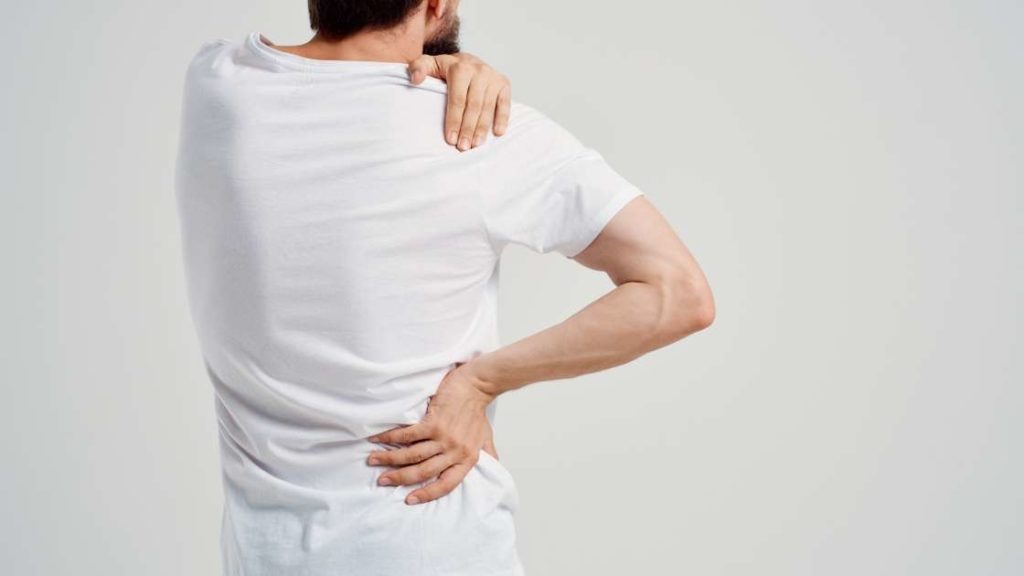What Does It Mean to Throw Out Your Back?

What exactly does it mean to throw out your back? The very term throwing your back out sounds like the result of a strenuous activity gone wrong. And oftentimes, that’s accurate. You may have lifted a heavy box using improper form. Maybe you overdid it on the rowing machine. Or perhaps you walked downstairs with your vision blocked by an overflowing laundry basket and tripped on the way down. I hate when all of those things happen.
But really, it doesn’t take a brutal accident in order to throw out your back. There’s far easier ways to do it. Sitting in front of your computer, which is about as sedentary as it gets, can throw your back out worse than a poorly executed barbell squat. You don’t even have to be conscious to throw out your back, considering how many of us sleep awkwardly and/or need a new mattress. It’s no wonder why back pain is one of the most common aches my patients report.
To restate the question: what does it mean to throw out your back? I’ll give you the answer, and I’ll follow up with how to prevent it!
What Does it Mean to Throw Out Your Back?
It’s more straightforward than it sounds. Throwing out your back means you’ve strained your back muscles, usually in the lower back. A thrown out back involves the over-stretching or tearing of muscles, tendons, ligaments, and blood vessels in the back. It can be caused by injury, or be the result of a medical condition such as a slipped disk.
When you throw out one of the highlighted muscles shown above, you may experience one or all of the following symptoms:
- Dull or sharp pain in back
- Muscular tightness and spasms
- Stiffness and limited range of motion
- Poor posture
How Can it Be Prevented?
There will be a little repetition here, as I did mention a few causes in the introduction section. Doing the opposite of the actions that cause a thrown out back is just one means of prevention.
- Use proper form
-
- Whether you’re at the gym or sprucing up the house, don’t put yourself in a position that will overstretch your back. Know your range of motion when twisting your trunk and don’t surpass it. If you need to pick something up, be it a kettlebell or a spoon you dropped, bend at the knees and lift with the legs.
-
- Don’t over exercise
-
- This will put you at risk for muscular adhesions, which can in turn lead to muscle tears. I’m always telling my patients about how stretching an adhesed muscle is like pulling a rope with a knot in it; that rope is not going to come loose!
-
- Be mindful when sitting
-
- Especially when sitting for long periods of time! All that hunching will pull on your neck muscles, which pull on your upper back muscles, which then pull on your low back muscles. It’s all connected.
- If you work at a desk, make sure to give yourself breaks and walk around for a few minutes here and there.
-
- Work on your posture
-
- Not just while you’re sitting down. Poor posture is the most common cause of muscular pain in general, not just in the back.
- Here’s an article I wrote about making small adjustments to your posture!
-
- Apply hold/cold therapy
-
- This is both a preventive and restorative treatment for a thrown out back! Heat soothes and loosens muscles, easing pre-existing pain and preventing pain that arises from tightness. Ice both reduces and prevents inflammation. Apply a heat pack to your back for 15 minutes, and follow up with an ice pack for another 15 minutes. You can do this four times per day.
- Here’s another helpful article, if you want to know more about heat/ice therapy!
-
- Receive bodywork
-
- Promote good posture and improve range of motion with chiropractic care or massage therapy. When you’re well aligned and more flexible, you’re less likely to injure yourself.
-
Now You Know!
Take control of back pain before it happens!
Katrina Jenkins
Author, Licensed Massage Therapist
Katrina Jenkins graduated from Towson University in 2013 with a Bachelor’s Degree in Health Science and worked as a nurse’s aide briefly before pursuing her true passion. She graduated from the Massage Therapy Institute of Colorado in April 2016 with honors and completed the Touch of Healers Scholarship Program the following summer. She has been a part of the Moyer Total Wellness Team since the summer of 2017.
Resources
Blanchette, Marc-André, et al. “Effectiveness and Economic Evaluation of Chiropractic Care for the Treatment of Low Back Pain: A Systematic Review of Pragmatic Studies.” PLOS ONE, vol. 11, no. 8, 3 Aug. 2016, p. e0160037, 10.1371/journal.pone.0160037.
Fletcher, Jenna. “Thrown out Back: What to Do, Treatments, and Causes.” Www.medicalnewstoday.com, 29 Jan. 2021, www.medicalnewstoday.com/articles/thrown-out-back. Accessed 1 Mar. 2021.
Nall, MSN, CRNA, Rachel. “Thrown out Back: Causes, Symptoms, and Treatments.” Healthline, 17 May 2019, www.healthline.com/health/back-pain/thrown-out-back#causes. Accessed 1 Mar. 2021.
Photo Credit
Canva by Shotprime
Canva by ChesiireCat
